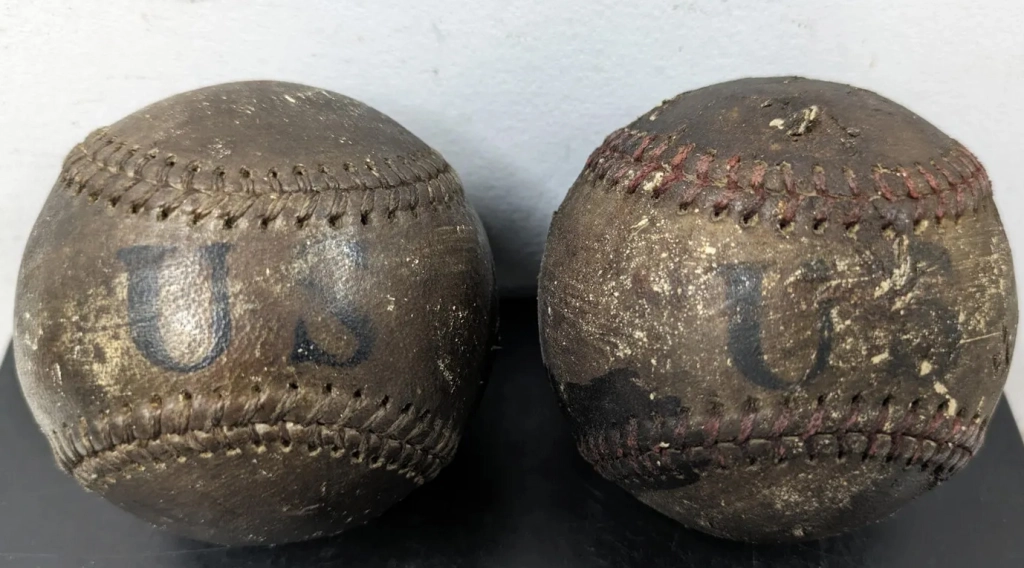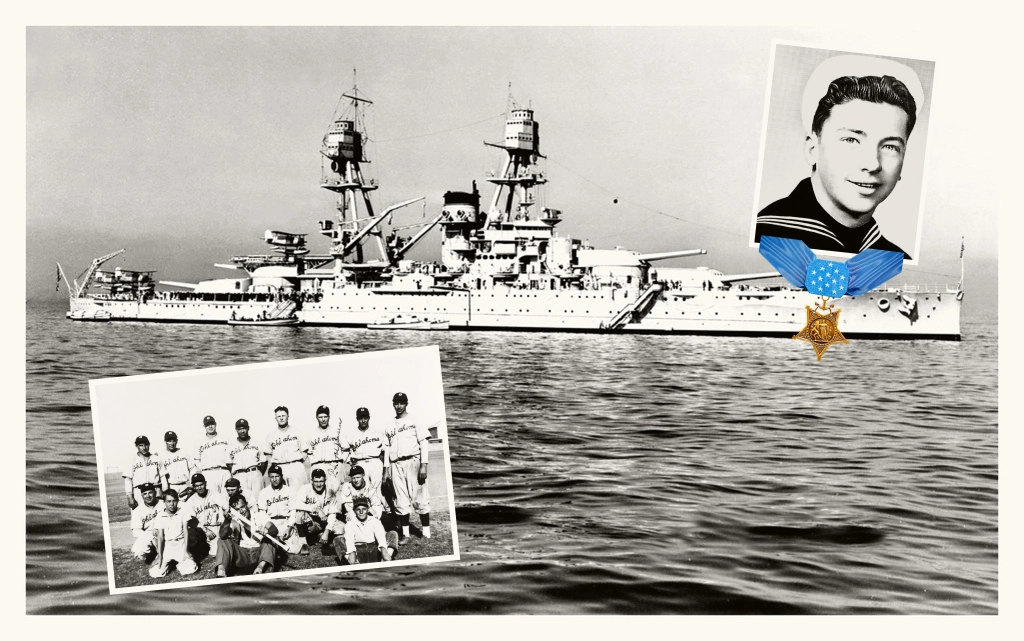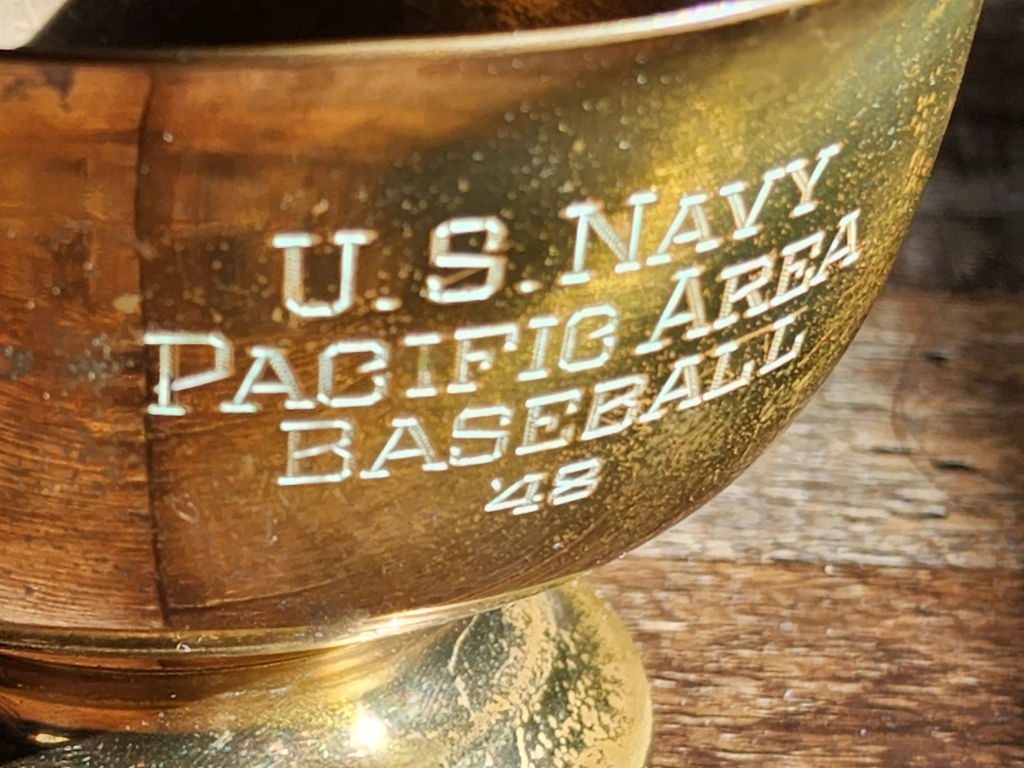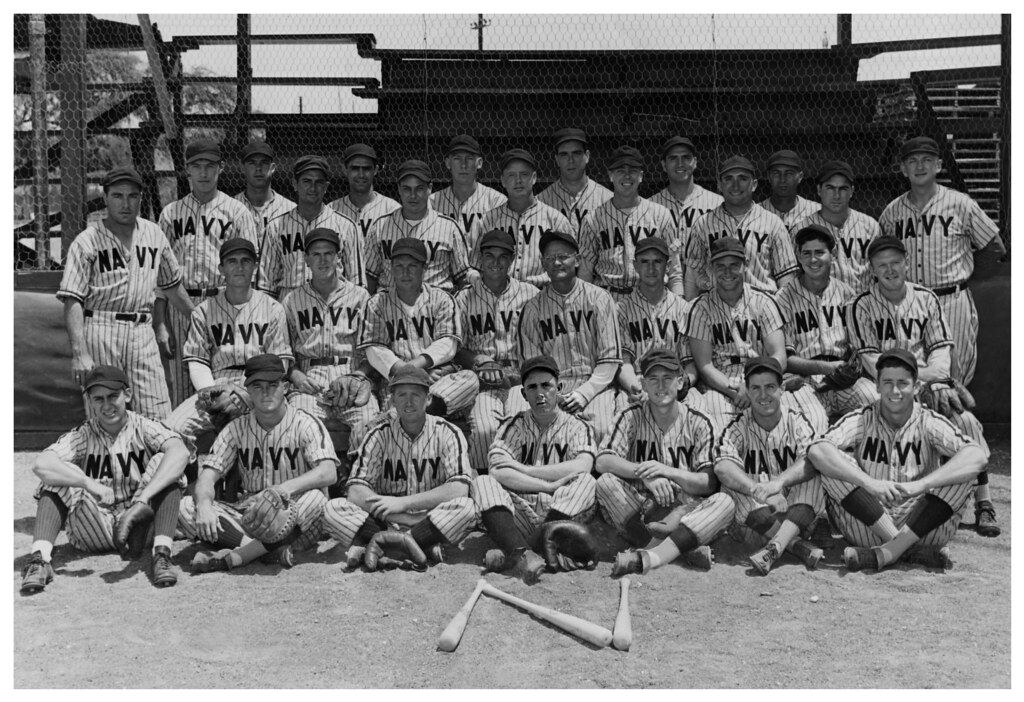If it was at all possible to achieve, one of the more ambitious goals with my growing archive of vintage photographs depicting military baseball is to identify every person within each image. To underscore the difficulties that surround such a lofty objective, this very task was one that, though successful, was not an easy exercise in facial recognition as I thought it was for a group of four 1944-45 U.S. Navy baseball snapshots.
Vintage baseball photograph collecting has its traps and minefields to navigate for even the most experienced and knowledgeable collector. Knowing the difference between a News Service and a Wire Service photo can help to protect potential buyers from grossly over-paying for prints. That same skill will also serve collectors well with recognizing a treasure among more common artifacts. Within my collection of military-centric vintage baseball photographs are candid snapshot-type photographs, taken by everyday GIs during their time in uniform.
Besides the rudimentary and unprofessional characteristics that are common among amateur photographers’ work, snapshots afford perspectives that are not routinely seen, especially surrounding events that have professional or press photographers creating images. The enjoyment gained within these vantage points is, however balanced out against the typical issues that are associated with non-professional photogs’ photographic prowess. Detracting features of snapshots can vary from poor exposure, lack of focus, under/over developing, chemical stains (from the processing) and damage from excessive handling or being mounted to photo album pages.

When a group of four snapshot photographs of candidly posed Navy baseball players was listed at auction a while ago, I didn’t hesitate to place my sniped bids based solely upon the subjects in each image. Each central subject was of a ballplayer wearing a baseball uniform surrounded by teammates, opponents and servicemen. The crowds in the background seemed to indicate that the images were captured following the conclusion of a game that was played before crowds of Navy and Marine Corps personnel. Each of the four central ball players seemed to have recognizable faces. I was certain of the identities of two of the four men and set out to identify the other two. The seller listed the photos stating that they originated from an estate of a husband and wife who were both serving in the armed forces and stationed at Pearl Harbor during World War II.
Each photo is sized the same: 4-½” x 2-½” making the images somewhat small and requiring significant magnification or my preference, a very high-resolution scan to truly evaluate the subjects. Judging by the uniforms and the two players that I was sure of (Johnny Vander Meer and Johnny Mize) and the known timelines of their service overseas (commencing with the service teams in the Central Pacific or Hawaii Leagues), I could narrow down the list of known Navy professional ballplayers. Upon their arrival in the post, I began comparing the faces of the central subjects within each image against photos in my collection and with online resources as I attempted to correlate them with faces of names on Navy team rosters.
Self-assured in my assessment of having two of the identities nailed down (Johnny Mize and Johnny Vander Meer), I began seeking external assistance among my baseball historian peers, initially via private messaging and emails. The responses to the inquiries echoed my own thoughts regarding these two gentlemen. Their faces look very familiar and yet the identities are out of my recollective reach. My next step was to expand my call for help by floating the request and photos across a few of the historical baseball social media groups of which I am a member.
After a few weeks of sharing the photographs and garnering similar (to previous requests for assistance), I was connected to an author and fellow Navy veteran who had written and published a book that was the result of his extensive research surrounding Navy baseball during WWII. Harrington Crissey, Jr. (author of Athletes Away: A Selective Look At Professional Baseball Players In The Navy During World War II) responded to my inquiry and threw a bit of a wrench into my thoughts for one of the two that I identified. “The set of four photos you sent me are of Bob Harris, Vern Olsen, Johnny Mize and George ‘Skeets’ Dickey, who was Bill Dickey’s brother,” wrote Crissey. In addition to the identities, narrowing down the date and location possibilities was one of my objectives. Mr. Crissey added, “Given the uniforms they are wearing, I’m almost certain the photos were taken during the Service World Series (a.k.a Army All Stars vs Navy All Stars Championship Series) which took place in the Hawaiian Islands between September 22 and October 15, 1944.” All four of the men were listed among all of the individual scorecards that I have seen from the 11-game series.
Armed with Mr. Crissey’s information, I reviewed the scans of the four images to validate his identifications. Vern Olsen and Bob Harris were quite obvious matches when I reviewed various photographs of them online. The confirmation of Mize being in one of the photos gave me a bit of relief that I had not mistaken him for someone else. Unfortunately, I missed badly on the photo that I thought was Vander Meer who was in fact, George Dickey (which I also validated with photographic comparisons) much to my disappointment. Once I had a few clear examples of both Vander Meer and Dickey to compare, a sense of near-embarrassment surrounds my mistake.
Vern Olsen, Pitcher, USN (1942-1945) – Chicago Cubs, Tulsa Oilers

Lavern Jarl Olsen was born to a Norwegian immigrant in the Portland, Oregon area and grew up playing baseball. By the time he was ready to begin his professional career, Vern signed a professional contract with the Pacific Coast League’s Angels of Los Angeles, an affiliate of the Chicago Cubs. Before taking the mound with the Angels, he was farmed out to the Ponca City Angels (Class “C” of the Western Association) of Oklahoma in 1937. Moving up to the Tulsa Oilers (Class “A” Texas League) for the 1938 and most of the ‘39 season, 37-20 record before getting called up to Chicago for four appearances. By 1940, Olsen was a full-time pitcher in the big leagues with the Cubs. Though he was injured and dealt with illness for most of 1942, Olsen’s tenure in Chicago was decidedly positive and he was seemingly on his way to a good major league pitching career posting a 30-26 record in 107 appearances. After the 1942 season came to a close, Olsen enlisted and found himself playing for Lieutenant Mickey Cochrane’s Great Lakes Naval Training Station team; the Blue Jackets.
By 1944, Olsen was pitching for the Aiea Hilltoppers in the Hawaiian League squaring off against other military teams (also stocked with professional talent). Olsen, along with the other three men in these photos, was a member of the fall of 1944 Army All Stars vs Navy All Stars Championship series that was played throughout the Hawaiian Islands. For 1945, Olsen was assigned to the Aiea Hospital baseball team in the 14th Naval District League. Vern Olsen did not play in the six-game 1945 Navy All-Star series (September 26-October 7, 1945) played after the Japanese Surrender and was discharged late in 1945. Vern reported to the Cubs’ spring training and made the team though he struggled to remain healthy having lost much of his pre-service baseball strength and conditioning. Olsen was limited to sporadic use, pitching only 9-2/3-innings in five appearances which resulted in his release at the end of the season. In 1947, Olsen was in camp with the Giants briefly before finding his way to Tulsa where he made two pitching appearances for a total of four innings after which, he retired from the game.
Bob Harris – USN (1942-1945) – Detroit, St. Louis Browns, Philadelphia A’s

A big right-handed pitcher, 6-foot tall Harris made his major league debut in 1938 with the Detroit Tigers on September 19, 1938 following four minor league seasons. Facing the Senators at Briggs Stadium, Harris entered the game at the top of the eighth inning with his team already trailing the Nats, 11-2, Bob faced nine batters over the final two frames surrendering three hits and one earned run while striking out one batter and not yielding any free passes. Though Harris might not have been pleased with his first major league performance, it is no doubt that his family, friends and his home state were proud of his accomplishment as he became the first major league ball player hailing from Wyoming. Harris would make two more appearances in ‘38 (one in relief and one as a starter) notching his first win – a complete-game at Cleveland on the last day of the season. Harris would make just five appearances with the Tigers in 1939 before being traded to the hapless St. Louis Browns with four other Detroit teammates.
From 1939 through the end of the 1942 season, Harris posted a 30-61 record and a 4.68 earned run average. Control seemed to be a challenge for him to acquire on the mound as he surrendered 323 free passes against 224 strikeouts. Harris went the distance in 27 starts with five shutouts showing that there were bright spots in those seasons before the War. With the 1942 season fully in Harris’ rear-view mirror and the War in the Pacific was a slugfest with the Japanese in the Solomon Islands, the 27-year-old major leaguer volunteered for Naval service, enlisting on November 15th. After completing his training at Tunny’s athletic specialist’s school at the Bainbridge Naval Training Station, Harris was pulled onto Lieutenant Commander Mickey Cochrane’s Great Lakes Blue Jackets squad, joining the three other subjects of this article (Olsen, Dickey and Mize) on, perhaps one of the most dominating forces in wartime service team baseball for the 1943 season.
Following his season with Great Lakes, Harris returned to Bainbridge Naval Training Station (Center) and this time filled a roster spot with the base’s service team; the Commodores. Johnny Mize, Vern Olsen, Johnny Lucadello, Ed Pelligrini, Joe Grace, Tom Ferrick and Marven Felderman. However, part way through 1944, these eight ballplayers found themselves making their way to the Central Pacific and onto various teams within the Hawaii League. Fellow Bainbridge teammates, Johnny Pesky, Barney McCoskey and Bob Scheffing remained with the Bainbridge team for the time-being. In June, Harris was assigned to the 14th Naval District team of veritable major league all-stars that were an indicator of the future dominance of Navy baseball in the Hawaiian Islands and the Pacific Theater for the remainder of the War. Harris made his way to the Pearl Harbor Submarine Base’s ball team in early July that saw action against five other teams including the inevitable 1944 league champions, the 7th Army Air Force.
Rounding out the 1944 Hawaii League season, Bob Harris found himself as part of the Navy All Star team that resoundingly defeated the Army All Stars in four straight games to win the championship. Though the series victory was sealed, both teams agreed to play all seven games (prior to game one) which the Navy continued their win streak through six. Left off the Third and Fifth Fleet tours of the Western Pacific, Harris rejoined the Pearl Harbor Submarine Base team, participating in the 14th Naval District League for the 1945 season.
Following his service in the Navy, the 31-year-old pitcher made an attempt to resume his professional career in the game splitting time in 1946 between the Toledo Mud Hens and the Milwaukee Brewers, both in the American Association, appearing in just 16 games. Retired from playing, Harris was managing the North Platte (Nebraska) Plainsmen ball club in 1949 and by 1956, was working as an insurance salesman.
George “Skeets” Dickey – USN (1942 – 1945) – Boston Red Sox, Chicago White Sox

Playing in the shadow of his older brother Bill, one could argue that the pathway to the major leagues was paved. Lacking the talent possessed by his hall of fame sibling, George was greatly limited in the number of games he played in during his six-year major league career. When the United States entered WWII and baseball was given the “green light” (by President Roosevelt in January of 1942) to continue, some ball players began to stream into the armed forces to join the fight. George’s baseball season came to an end on September 25th of 1942 as the White Sox finished sixth in the American League with a 66-82 record, beating the Indians (8-1) in front of 200 fans at League Park. Dickey’s season ended the day before playing in his last game, reaching base once (base on balls) in four appearances. Eighteen days later, George Dickey was in the Navy at the Great Lakes Naval Training Station and would join manager Mickey Cochrane’s squad for the 1943 season while serving as an anti-aircraft gunnery instructor. Following the team’s dominant performance, George (along with Johnny Mize) was transferred to Bainbridge Naval Training Center.
As the Navy began to assemble the top baseball talent in the Hawaiian Islands in 1944, George Dickey was transferred to Oahu and assigned to the Aiea Naval Hospital ball club joining his former Great Lakes teammate, Vern Olsen and fellow major leaguers Pee Wee Reese, Hank Feimster and Jim Carlin on the roster. By the fall, Dickey would be pulled onto the Navy’s All-Star roster (for the aforementioned Army All-Stars versus Navy All-Stars Championship Series), joining his brother Bill (who managed the team) and the other three Navy ball players (in this group of snapshots). George would find himself as part of a 28-man contingent (comprising the Third and Fifth Fleet teams) touring the forward areas of the Pacific, taking baseball to islands including Guam, Tinian and Saipan to entertain the troops.
Dickey returned to the Chicago White Sox in 1947 and played for just two seasons following the war. In 1948, George played for the Southern Association’s Birmingham Barons before he retired from the game.
Johnny Mize – USN (1943-1945) – St. Louis Cardinals, New York Giants

As with the three other ballplayers depicted in these photos, Mize began his naval service playing ball on Cochrane’s Great Lakes Blue Jackets squad in 1943. Following a stint at the Bainbridge Naval Training Center, Mize would be part of the exodus of domestic Navy service team players heading over to Hawaii to participate in the Hawaiian Leagues.
As the Navy dispersed their talent to various teams in the league, Johnny Mize found himself playing alongside fellow major leaguers Marv Felderman, Hugh Casey and Tom Ferrick on the Kaneohe Bay Naval Air Station’s Klippers. The team, managed by Lieutenant Commander Wes Schulmerich (who previously managed the Navy Pre-Flight Cloudbusters at Chapel Hill) suffered due to injuries sustained by two key players; Felderman and Mize, finishing in fifth place behind the Aiea Barracks Maroons. In third place were the Pearl Harbor Submarine Base Dolphins followed by second place Aiea Naval Hospital Hilltoppers and the league champions, the Flyers of the 7th Army Air Force.
By the season’s end, Navy brass pulled Mize onto the Navy’s All-Star team to square off against the Army’s All Stars in a series that was so loaded with a caliber of talent not seen in the major leagues since the 1941 season. Following the Navy’s easy victory in the All-Star Championship Series, Mize was assigned to play baseball in the forward Pacific Islands in 1945 joining George Dickey and 26 other sailors on a baseball tour, entertaining the troops in the forward areas. After the Japanese surrender, Mize returned home and was discharge in October, resuming his career with the Giants in 1946 on his way to the Hall of Fame.
These four simple photographs provide small vignettes into a moment that was experienced by an unknown WWII navy veteran who could have been convalescing as he recovered from wounds sustained during the War. For the person who has reservations about these men who played the game while most American young men were off fighting, it is recommended that they observe the veterans among these four players. Understanding what it meant to have a few hours’ break from the pain of recovery or the monotonous life of serving aboard ship or faraway places would change most negative perspectives.
Baseball was transportive and transformative for our troops and remains the same today.
References:




Leave a comment